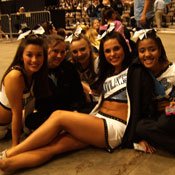Some girls dream of being movie stars. Lexi Worsham dreams of cheerleading.
As a member of the Mississippi Cheerleading Academy Outlaws, a competitive cheerleading squad, Lexi is living her dream. She is merely an eight-grader; however, even at the young age of 14, she is confident in her passion to cheer and in her status as an athlete. When she learned of a recent court decision ruling that cheerleading is not a sport, Lexi's passion for cheering took center stage.
"It is a sport!" She exclaimed. "We practice just as hard as football players. ... All the people who say it isn't a sport have never tried it."
In Biediger v. Quinnipiac University, the women's volleyball team sued the university under Title IX of the Education Amendments of 1972 after the school eliminated the sport from its athletic program to institute competitive cheerleading. Title IX "prohibits discrimination on the basis of sex in education programs and activities."
Ruling in favor of the volleyball team, the court held that competitive cheerleading is an athletic undertaking but does not qualify as a varsity sport. It is "too underdeveloped and disorganized" to be considered a "genuine varsity athletic participation" opportunity for women, according to the ruling, which was largely based on the fact that the NCAA has not found competitive cheerleading to be a varsity sport.
Before it considers any sport a varsity sport, the NCAA first requires it to be an "emerging sport," a classification "intended to provide additional athletics opportunities to female student athletes," the NCAA states on its website. Being classified as an emerging sport allows institutions to use the sport to help meet NCAA minimum sports-sponsorship requirements and minimum financial-aid awards.
Today, cheerleading goes beyond sideline entertainment at football games. It has expanded into a genre called "competitive cheerleading," and is popular locally and nationally.
Competitive cheer teams are similar to sideline cheer squads except that their routines are more athletic and aerobatic. Whereas "sideline cheerleaders primarily work to entertain audiences ... competitive cheer teams strictly engage in sport," the Biedeger decision states.
The men and women who make up competitive cheer teams do not consider themselves entertainers. They are athletic competitors. But despite the hard work, agility and strength involved in competitive cheerleading, legally, it is still not regarded as a sport.
Two associations exist for competitive cheerleading: the National Collegiate Acrobatics and Tumbling Association, affiliated with USA Gymnastics; and STUNT of USA Cheer. To the average viewer, they may appear the same. USA Cheer, however, emphasizes its desire to remain in the traditional cheerleading community, while NCATA focuses on the acrobatics and tumbling aspect of the sport.
In 2010, both groups applied for NCAA emerging-sport status. In response, the NCAA requested that the groups collaborate and submit one proposal. "[T]wo similar, competing concepts are confusing and counter-productive to the overall mission and goals of the emerging sports for women program," the NCAA said.
It requested additional data (including participation numbers, diversity of opportunities, specific injury data and risks, growth in youth sport format) and 10 letters of commitment from member institutions that sponsor or intend to sponsor the sport.
David Hanbery is the founder of Deep South Cheer and Dance in Ridgeland, a company that hosts cheer and dance competitions and events throughout the southeast. Using NASCAR as an example, Hanbery says that it is difficult to classify a sport, but agrees that cheerleading is an athletic event.
"At the university level, the athlete's primary role is to be entertainment for the crowd, but for teams that actually compete, it is a sport," he said, adding: "When cheerleaders go to camp, they compete against each other, and it's a big deal. So, since they compete, yes, it's a sport."
Hanbery believes that competitive cheerleading needs to be more structured to develop to the point where it will satisfy the Department of Education and the NCAA requirements. "There needs to be a governing body—a nonprofit organization—in charge, because the NCAA does not have the money to do it," he says.
"Right now, cheerleading is run by industry and large companies who profit from it. It's hard to develop it because so many different people are creating different rules. ... Coaches and participants are going to have get involved and take it over to create standard rules."
Hanbery is optimistic about competitive cheerleading's future. "Eventually, universally, it will be classified as a sport," he says. "Cheerleading is huge and growing all over the world. Within the next decade, it will shift from being a sideline group of people, to a major, competitive sport like gymnastics and ice skating."



Comments
Use the comment form below to begin a discussion about this content.